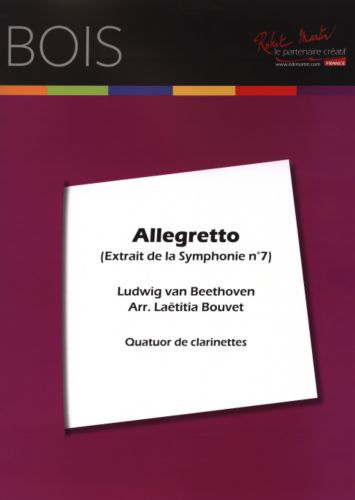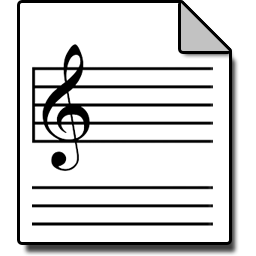On order, usually dispatched within 5 days
ALLEGRETTO FROM SYMPHONY N 7
 (BEET05855) :
€ 19,23
(BEET05855) :
€ 19,23


 Ludwig VAN BEETHOVEN
Ludwig VAN BEETHOVEN
Arr : LAETITIA BOUVET
Publisher : Editions Robert Martin
Duration : 3'00
Genre : Instrumental music
Group : Clarinet
Genre : Instrumental music
Group : Clarinet



Add € 35,00 of eligible items (1) to your order to qualify for FREE Shipping (2) in FRANCE
(1)Instrumental music (2)Free shipping cost : € 0,01

Laëtitia Bouvet offers us an arrangement for clarinet quartet from the Allegretto of La Symphonie n 7.
Symphony No. 7 in A major, op 92 by Ludwig van Beethoven is one of the nine symphonies of the composer, for symphony orchestra, en 4 movements, composed between 1811 et 1812. Son 2e mouvement Allegretto est « une de mes meilleures ?uvres » selon le compositeur, an "apotheosis of dance ..." according to Richard Wagner.
Beethoven composes this grand symphony during the terrible period of the Russian campaign in 1812 Napoleonic wars (1803-1815) against the Holy Roman Empire, at the same time as his Symphony No. 8, during a spa treatment in Teplitz in Bohemia, or aged 41 years, he tries to cure his beginnings of growing deafness caused by an otosclerosis. He meets Goethe during this period, with whom he shares his deepest patriotic torments at the end of the war.
Its first execution takes place on 8 December 1813 for a charity concert at the University of Vienna in Austria, with a symphony orchestra led by himself, composed of many famous musicians including Louis Spohr, Giacomo Meyerbeer, Mauro Giuliani, Johann Nepomuk Hummel, Ignaz Moscheles, Domenico Dragonetti, Andreas Romberg, and Antonio Salieri .... This patriotic charity concert given for the wounded soldiers of the battle of Hanau (October 1813) ou il interprète également son ?uvre La Victoire de Wellington, exalts the Austrians and the troops of the Sixth Coalition against the Napoleonic army of Emperor Napoleon I. His success was such that he had to replay his famous 2nd movement Allegretto as a recall.
Richard Wagner cite dyears son ouvrage L'?uvre d'Art du Futur de 1849 "The symphony is the apotheosis of dance : it is dance in its supreme essenceyears, la réalisation la plus bénie du mouvement du corps presque idéalement concentré dyears le son. Beethoven dyears ses ?uvres a mis le corps en musique, mettant en ?uvre la fusion du corps et de l'esprit ».
Google machine translation: Original story of the work
Symphony No. 7 in A major, op 92 by Ludwig van Beethoven is one of the nine symphonies of the composer, for symphony orchestra, en 4 movements, composed between 1811 et 1812. Son 2e mouvement Allegretto est « une de mes meilleures ?uvres » selon le compositeur, an "apotheosis of dance ..." according to Richard Wagner.
Beethoven composes this grand symphony during the terrible period of the Russian campaign in 1812 Napoleonic wars (1803-1815) against the Holy Roman Empire, at the same time as his Symphony No. 8, during a spa treatment in Teplitz in Bohemia, or aged 41 years, he tries to cure his beginnings of growing deafness caused by an otosclerosis. He meets Goethe during this period, with whom he shares his deepest patriotic torments at the end of the war.
Its first execution takes place on 8 December 1813 for a charity concert at the University of Vienna in Austria, with a symphony orchestra led by himself, composed of many famous musicians including Louis Spohr, Giacomo Meyerbeer, Mauro Giuliani, Johann Nepomuk Hummel, Ignaz Moscheles, Domenico Dragonetti, Andreas Romberg, and Antonio Salieri .... This patriotic charity concert given for the wounded soldiers of the battle of Hanau (October 1813) ou il interprète également son ?uvre La Victoire de Wellington, exalts the Austrians and the troops of the Sixth Coalition against the Napoleonic army of Emperor Napoleon I. His success was such that he had to replay his famous 2nd movement Allegretto as a recall.
Richard Wagner cite dyears son ouvrage L'?uvre d'Art du Futur de 1849 "The symphony is the apotheosis of dance : it is dance in its supreme essenceyears, la réalisation la plus bénie du mouvement du corps presque idéalement concentré dyears le son. Beethoven dyears ses ?uvres a mis le corps en musique, mettant en ?uvre la fusion du corps et de l'esprit ».
Google machine translation: Original story of the work



